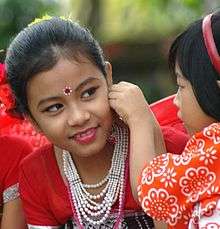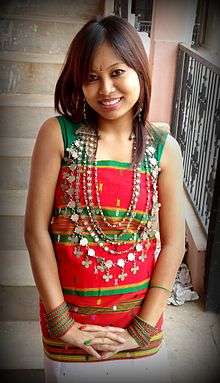Culture of Tripura



Culture of Tripura is similar to those of Native indigenous tribal peoples of Northeast India. However like Assam, Manipur, Burma and Southeast Asia culture of Tripura is characterized in small portion living in plain areas by mainstream Indian cultural influence spearheaded by Bengali culture coexisting with tribal traditional practices specially living in those plain areas, not much extending to Hill people of Tripura notably the Tripuri culture. Tripura is a state in North East India. In the 2001 census of India, Bengalis represented almost 70% of Tripura's population and the tribal population comprised 30% of Tripura's population.The tribal population comprises several different tribes and ethnic groups with diverse languages and cultures. The largest tribal group was the Kokborok-speaking tribe of the Tripuri who had a population of 543,848 in 2001 census,[1] representing 16.99% of the state population and 54.7% of the scheduled tribe population.[1] The other major tribes in order of decreasing population were Reang (16.6% of the tribal population), Jamatia (7.5%), Chakma (6.5%), Halam (4.8%), Mog (3.1%), Munda, Kuki tribes and Garo.[1] Bengali is the most spoken language, due to the predominance of Bengali people in the state. Kokborok is a prominent language among the tribes. Several other languages belonging to Indo-European and Sino-Tibetan families are spoken by the different tribes.
Tripura has several diverse ethno-linguistic groups, which has given rise to a composite culture. The dominant cultures are Bengali, Manipuri, Tripuris, Jamatia, Reang, Noatia, Koloi, Murasing, Chakma, Halam, Garo, Kuki, Mizo, Mogh, Munda, Oraon, Santhal, and Uchoi.
Bengali culture
Bengali people represent the largest non-tribal community of the state. Bengali culture, as a result, is the main non-tribal culture in the state. Indeed many tribal families, especially those who are from the elite class and reside in urban centres, have embraced Bengali culture more than their tribal cultural roots.[2] The Tripuri kings were great patron of Bengali culture, especially literature,[2] and Bengali language was the language of the court.[3] The Nobel laureate Bengali poet Rabindranath Tagore had notable friendship with the kings.[3] Elements of Bengali culture, such as Bengali literature, Bengali music, and Bengali cuisine predominate particularly in the urban areas of the state.
Handicrafts
Tripura is noted for bamboo and cane handicrafts.[4] Bamboo played important part in the jhumia (shifting cultivation) of the tribes. It was used to make watch stations on stilts, and was devised to carry food and water. Besides these usages, bamboo, woods and cane were used to create an array of furniture, utensils, hand-held fans, replicas, mats, baskets, idols and interior decoration materials.[5][6]
Songs and dances
Music and dances are integral part of the tribal people of Tripura. Some of their indigenous musical instruments are the sarinda, chongpreng, and sumui (a kind of flute). Songs are sung during religious occasions, weddings, and other festivals. Each tribal community has their own repertoire of songs and dances. The Tripuri and Jamatia tribe perform goria dance during the Goria puja. Jhum dance (also called tangbiti dance) in the harvest season, lebang dance, mamita dance, and mosak sulmani dance are other Tripuri dances.[7] Reang community, the second largest tribe of the state, are noted for their hojagiri dance performed by young girls balancing on earthen pitchers.[7] The Bizhu dance is performed by the Chakmas during the Bizhu festival (the last day of the month of Chaitra). Other tribal dances are wangala dance of the Garo people, hai-hak dance of the Halam branch of Kuki people, sangrai dance and owa dance of the Mog tribe, and others.[7] Besides tribal music, Indian classical music is also practiced among the residents. Sachin Dev Burman of the royal family was a maestro in the filmi genre of Indian music, creating many popular tunes in the bollywood films.
Festivals and worships
Hindus believe that Tripureshwari is the patron goddess of Tripura and an aspect of Shakti. Several fertility gods are also worshiped by the tribes, such as Lam-Pra (the twin deities of sky and sea), Mailu-ma (goddess of corn, identified with Lakshmi), Khulu-ma (goddess of the cotton plant), and Burha-cha (god of healing). Durga Puja, Kali Puja, Ashokastami and the worship of the Chaturdasha deities are important festivals. Several festivals represent confluence of several tribal traditions, such as Ganga puja, Garia puja, Kherchi puja, Ker puja.[8][9]
Sculpture and architecture

Unakoti, Pilak and Devtamura are historic sites where large collections of stone carvings and rock sculptures are noted.[4][10] These sculptures are evidence of the presence of Buddhism and Brahmanical orders for centuries. These sculptures represent a rare artistic fusion of traditional religions and tribal influence.[11][12][13]
Sports
Football and cricket are the most popular sports in the state. The state capital Agartala has its own club football championships every year where many local clubs compete in a league and knockout format. Tripura participates as an eastern state team in the Ranji Trophy, the Indian domestic cricket competition. The state also is a regular participant of the Indian National Games and the North Eastern Games. Tripura produced a few nationally successful players in gymnastics and swimming, but overall contribution in athletics, cricket, football and indoor games remained poor.[14]
References
- 1 2 3 "Tripura data highlights: the scheduled tribes" (PDF). Registrar General & Census Commissioner, India. Retrieved 20 April 2012.
- 1 2 Paul, Manas (19 April 2010). The Eyewitness: Tales from Tripura's Ethnic Conflict. Lancer Publishers. p. 104. ISBN 978-1-935501-15-2. Retrieved 10 July 2012.
- 1 2 Boland-Crewe, Tara; Lea, David (15 November 2002). The Territories and States of India. Psychology Press. p. 238. ISBN 978-1-85743-148-3. Retrieved 10 July 2012.
- 1 2 Chaudhury, Saroj (2009). "Tripura: a composite culture" (PDF). Glimpses from the North-East. National Knowledge Commission. pp. 55–61. Retrieved 5 July 2012.
- ↑ "Handicrafts". Government of Tripura. Retrieved 7 July 2012.
- ↑ Chakraborty, Kiran Sankar (2006). Entrepreneurship and small business development: with special reference to Tripura. Mittal Publications. pp. 39–41. ISBN 9788183241250.
- 1 2 3 "The folk dance and music of Tripura" (PDF). Tripura Tribal Areas Autonomous District Council. Retrieved 7 July 2012.
- ↑ Sharma, A.P. "Tripura festival". Famous festivals of India. Pinnacle Technology. ISBN 978-1-61820-288-8. Retrieved 9 July 2012.
- ↑ "Fairs and festivals". Government of Tripura. Archived from the original on 4 February 2012. Retrieved 7 July 2012.
- ↑ "Tripura sculptures, rock images speak of glorious past". Deccan Herald. 25 July 2008. Archived from the original on 5 January 2015. Retrieved 7 July 2012.
- ↑ Chauley, G. C. (1 September 2007). Art treasures of Unakoti, Tripura. Agam Kala Prakashan. ISBN 978-81-7320-066-3. Retrieved 8 July 2012.
- ↑ North East India History Association. Session (2003). Proceedings of North East India History Association. The Association. p. 13. Retrieved 8 July 2012.
- ↑ Chaudhuri, Saroj; Chaudhuri, Bikach (1983). Glimpses of Tripura. 1. Tripura Darpan Prakashani. p. 5. ASIN B0000CQFES. Retrieved 9 July 2012.
- ↑ Chanda, Subhasis (24 April 2002). "Sports development in Tripura". Press Information Bureau, Government of India. Retrieved 12 July 2012.